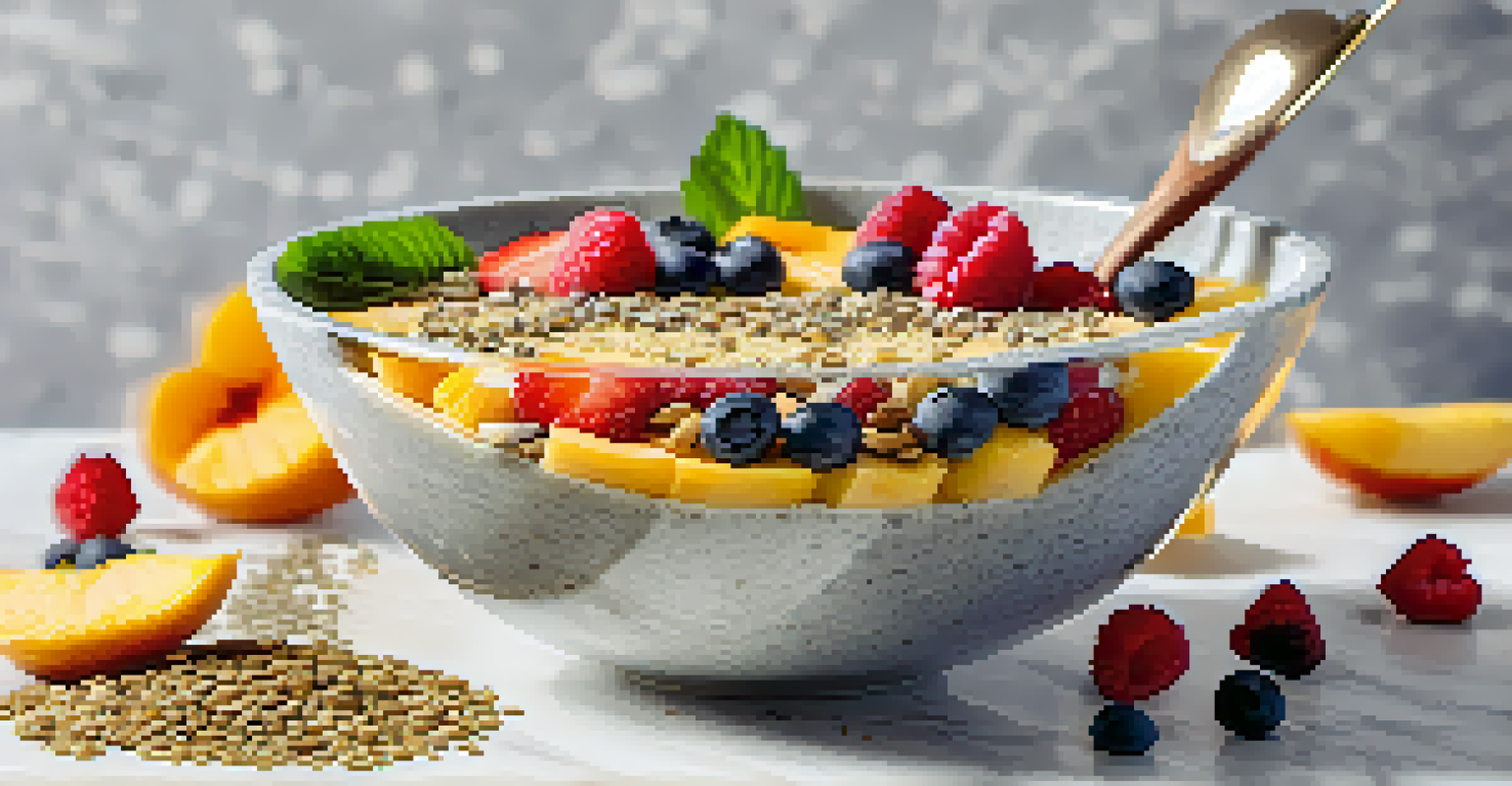Essential Amino Acids and Raw Food Diets: A Guide

What Are Essential Amino Acids and Why Are They Important?
Essential amino acids (EAAs) are the building blocks of protein that your body cannot synthesize on its own. This means you must obtain them through your diet. There are nine essential amino acids, and each plays a unique role in bodily functions, from muscle repair to hormone production. Without a sufficient intake of these EAAs, your body might struggle to maintain optimal health.
The food you eat can be either the safest and most powerful form of medicine or the slowest form of poison.
Incorporating the right amount of these amino acids is particularly crucial for those following a raw food diet. Since raw food diets primarily consist of uncooked fruits, vegetables, nuts, and seeds, it's easy to miss out on these essential nutrients. Therefore, understanding how to balance your diet to include these amino acids can significantly enhance your overall well-being.
For example, combining foods like quinoa and black beans can create a complete protein profile, providing all the essential amino acids necessary for your body. This kind of knowledge allows raw food enthusiasts to enjoy diverse meals while ensuring they meet their nutritional needs.
The Role of Essential Amino Acids in the Body
Essential amino acids play several roles in the body, including supporting muscle growth, repairing tissues, and producing enzymes and hormones. They are also vital for the synthesis of neurotransmitters, which help regulate mood and cognitive functions. When you consume adequate amounts of EAAs, you’re essentially fueling your body's engine, ensuring everything runs smoothly.

Amino acids can also impact your immune system and overall health. For example, leucine, one of the essential amino acids, is known for its role in muscle recovery after workouts. This is especially important for those on a raw food diet who may engage in regular physical activity and need to support their recovery effectively.
Essential Amino Acids Explained
Essential amino acids are vital nutrients that must be obtained through diet, as the body cannot produce them.
Moreover, a deficiency in essential amino acids can lead to various health issues, including fatigue, weakened immunity, and impaired cognitive function. Thus, understanding their roles can motivate you to prioritize a balanced diet that includes all nine essential amino acids.
Raw Food Diet: Benefits and Challenges
A raw food diet primarily consists of uncooked and unprocessed foods like fruits, vegetables, nuts, and seeds. This diet is often praised for its potential health benefits, including increased energy levels, improved digestion, and enhanced skin health. Many individuals report feeling more vibrant and alive when consuming a diet rich in raw foods, which can be attributed to the high levels of vitamins, minerals, and antioxidants present in these foods.
Let food be thy medicine and medicine be thy food.
However, the raw food diet comes with its own set of challenges. One of the biggest concerns is ensuring you get enough essential amino acids, as many raw plant-based foods are low in protein. This can lead to deficiencies if not carefully managed, especially for those who may not be aware of how to combine different foods to create a balanced protein profile.
To tackle these challenges, meal planning becomes crucial. By incorporating a variety of protein-rich raw foods, such as nuts, seeds, and sprouted legumes, you can create delicious meals that satisfy your nutritional needs while enjoying the benefits of a raw food lifestyle.
How to Get Essential Amino Acids on a Raw Food Diet
Getting enough essential amino acids on a raw food diet requires some strategic planning. While raw fruits and vegetables are nutritious, they often fall short in providing adequate protein. To ensure you meet your essential amino acid needs, consider incorporating foods like hemp seeds, chia seeds, and spirulina, which are rich in protein and can easily be added to smoothies or salads.
Another effective way to combine foods for a complete amino acid profile is through food pairing. For instance, pairing nuts with whole grains, like sprouted quinoa or buckwheat, can create a more balanced meal. This practice is similar to how rice and beans provide a complete protein source, allowing you to enjoy the benefits of raw foods while ensuring you're not missing out on essential nutrients.
Raw Food Diet Challenges
While a raw food diet offers numerous health benefits, it can pose challenges in meeting essential amino acid needs.
Lastly, being mindful about food variety is key. Regularly rotating your food choices can help you cover a broader spectrum of amino acids. By exploring new raw recipes and ingredients, you can keep your meals exciting while meeting your nutritional needs.
The Importance of Complete Proteins in Raw Diets
Complete proteins contain all nine essential amino acids, making them crucial for anyone, especially those on a raw food diet. While many plant-based foods are incomplete proteins, certain combinations can create a complete amino acid profile. Understanding this concept is vital for those looking to thrive on a raw food diet without compromising their health.
For example, foods like tempeh, which is fermented soy, or sprouted lentils, can be considered complete proteins when prepared correctly. These options can easily be incorporated into salads or raw wraps, providing both texture and nutrition. This way, you can enjoy the best of both worlds—delicious raw meals and adequate protein intake.
Moreover, complete proteins can help maintain muscle mass and support overall body functions. By focusing on including these complete sources in your diet, you can ensure that you not only feel great but also support your body's needs effectively.
Supplements: A Helpful Addition or Not?
When following a raw food diet, the question of supplements often arises. While it's best to get nutrients from whole foods, certain circumstances may require supplementation, especially for essential amino acids. Plant-based protein powders derived from sources like pea or brown rice can help fill in the nutritional gaps without compromising your raw food principles.
However, it's essential to choose supplements wisely. Look for high-quality, raw, and organic options that align with your dietary preferences. Some individuals might find it challenging to consume enough protein through food alone, so a well-chosen supplement can be a helpful addition to support their wellness goals.
Combining Foods for Complete Proteins
Pairing foods strategically can create complete proteins, ensuring a balanced intake of essential amino acids on a raw food diet.
Ultimately, supplements should complement a balanced diet rather than replace whole foods. By taking a mindful approach to supplementation, you can enhance your raw food journey while ensuring you meet your essential amino acid needs.
Practical Tips for Maintaining a Balanced Raw Food Diet
Maintaining a balanced raw food diet can seem daunting, but a few practical tips can make it easier. Start by meal prepping and planning your weekly meals to ensure you include a variety of protein sources. This helps avoid the monotony of eating the same foods and ensures a broader range of nutrients to support your health.
Another useful tip is to explore new recipes and raw food ideas regularly. Engaging with the raw food community through blogs, social media, or local groups can provide inspiration and new food combinations that are both delicious and nutritious. Plus, sharing your experiences can help motivate you to stick with your raw food journey.

Lastly, listen to your body. If you're feeling fatigued or unwell, it might be a sign that you need to adjust your diet. By being attentive to your body's signals, you can make informed choices that support your health while enjoying the benefits of a raw food lifestyle.